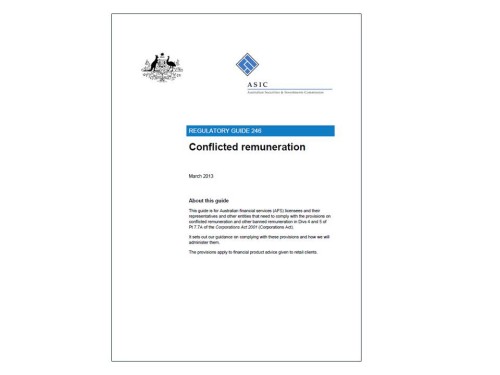RG246 and the future of fund manager rebates
At this moment there are probably hundreds of lawyers poring over RG246, ASIC’s regulatory guide to conflicted remuneration, and consensus about what it means in practice may take months to emerge.
RG246 has some laudable ambitions in addressing the impact of remuneration on advice, but there are some measures within it which appear excessive, to say the least. A good example is how it goes to tortuous lengths to restrict the remuneration of employees who sell their employer’s financial products to retail investors. You can receive a salary, but you can’t receive a bonus based primarily on sales success.
How you are supposed to pursue a career in selling financial products – should that be your ambition – is unclear. Indeed this career path appears to be effectively banned. Go and sell real estate instead (not covered by RG246) seems to be the implicit message.
Such absurdities aside, much of RG246 is more or less as expected. The part which appears to have moved rather a lot is the volume-based shelf-space fees, which covers rebates from fund managers to platforms.
If you’re familiar with the industry value chain, there are two main types of rebates which flow through it:
– Platforms to dealer groups. Banned, but grandfathered as at 1 July 2014.
– Fund managers to platforms (and retained by the platform as margin rather than passed on to investors). Banned if effectively a shelf space fee, but still permitted if it represented a flow of value based on the bargaining power of the parties.
This latter appears to have tightened considerably. The concept of bargaining power has disappeared in RG246, replaced by exemptions for “fees-for-services” from the platform to fund manager, and “scale efficiencies” derived by the fund manager from the volume delivered by the platform.
Both exemptions have hoops to be jumped through to qualify – think of hoops which are both small and on fire and you will get the idea:
– The fee-for-service exemption covers platform activities such as listing, monitoring, and reporting. It’s clear ASIC is expecting this fee to be largely fixed in nature or to vary with the number of funds, rather than growing with AUM. ASIC also intends to compare this fee across platforms (rebate police, anyone?). So a platform can likely charge a fixed dollar amount under this exemption – say $25,000 per fund – but it will be hard to charge a rebate of 40bps on AUM.
– It’s more likely that a bps of AUM rebate can continue to operate under the scale efficiencies exemption. However ASIC’s evidentiary requirements here are extraordinary, such as fund managers laying out their fixed and variable costs to platforms in order to justify the scale efficiencies achieved. You can imagine how much fund managers would love to do that (not). ASIC also suggests that platforms would need to secure a separate opinion from “an expert” (undefined) about the fund manager’s scale efficiencies statement.
These measures, while well intended, are exceptional in a world where real estate and stockbroker commissions survive, and where payments from consumer goods manufacturers to supermarkets for physical shelf-space remain commonplace.
In terms of impact on the wealth management industry, it’s another turn of the screw on the platform business model. Not all platforms receive fund manager rebates, but many do. And while not all those that receive such rebates retain them as margin – some such as Asgard have traditionally passed them through to investors – many do.
Yet again, the easiest way for a platform to respond is to vertically integrate. Profit margins may get trapped at different parts of the value chain, but if you own the whole value chain, you don’t really care. So just as FoFA encouraged vertical integration of advice, RG246 may encourage further vertical integration of asset management.
As with much investor protection regulation we have seen in recent years, one of the side effects has been the creation of ever larger vertically integrated competitors and reduced investor choice. RG246 looks little different.

